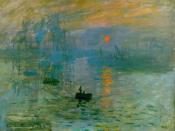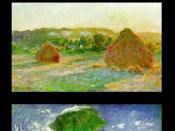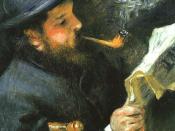Throughout history, there have been numerous artistic movements which have challenged the traditions of art and changed the ways in which art is created and viewed. However, none of these movements have been as revolutionary and ground-breaking as Modernism. Modernism, a period dating from roughly the eighteen sixties through the nineteen seventies, rejected conventional ways of making art and attempted to present "a new way of looking at the world" (Lawrence, 515) and what contemporary artists regarded as an emotionally truer picture of how people really feel and think (Christopher). There were many movements within Modernism, but none challenged conventional ideas about art to the same extent as Impressionism and Cubism. These two movements produced uniquely innovative artists whom, through their works, prepared the way for twentieth century art.
It is the truth that the Impressionist period was the first momentous progress towards challenging traditional ideas in art. Greatly influenced by the development of photography and color research during the nineteenth century, Impressionism allowed artists to concentrate on truths beyond external appearances.
Impressionist artists such as Claude Monet and Auguste Renoir, set out to achieve greater naturalism by capturing a fleeting moment by using light and color to create form and atmospheric effects (Lawrence, 515). These men were two of the first artists who rejected conventional Renaissance art ideas, attempted to alter the style, subject matter and purpose of painting. Accordingly, past paintings of historical or mythological themes were replaced by paintings that focused on people's lives.
Recognized as the "Father of Impressionism" (Cindy), Claude Monet is known to be one of the most contributing artists of the Impressionist period. Moreover, Monet was a founder of Impressionism, adhered to its principles throughout his long career and brought the study of the transient effects of natural light to its most...


